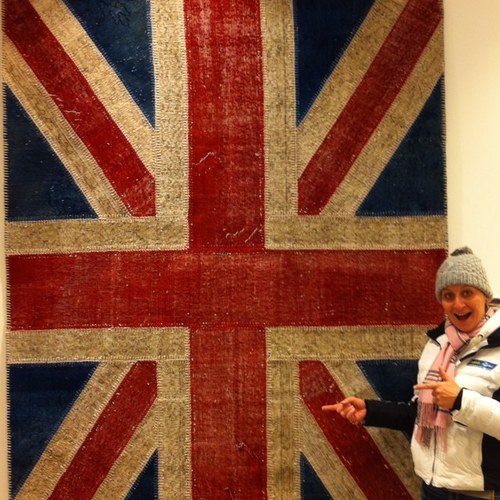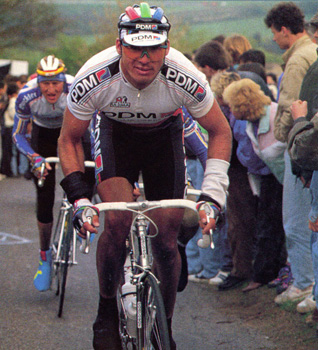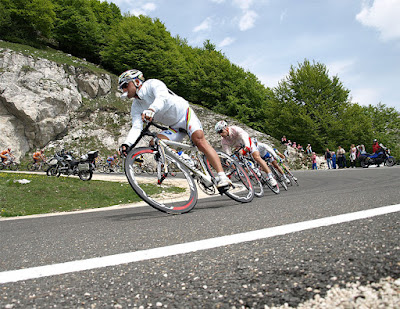 |
| Heiri Suter |
1934 was won by Gaston Rebry - in that same year, he also won Ronde van Vlaanderen and Paris-Nice. His victory was won as much through luck as skill: Roger Lapébie was disqualified after being declared winner when officials received word that he'd been spotted swapping to a different bike during the race. The new bike was identical but for one sticker, which an eagle-eyed judge noticed and so second place Rebry was declared winner.
The Ronde van Vlaanderen was held on this day in 1951, 1962, 1973, 1979, 1984, 1990 and 2012. 1951 was the year that Fiorenzo Magni became the second man to win three editions, but it was a year of firsts for the rider and for the race: he was the first man to have won three consecutive editions (and, to date, remains the only man to have done so), with 2nd and 3rd places going to the Frenchmen Bernard Gauthier and Attilio Redolfi it was the first year that no Belgian riders stood on the winner's podium, for the first time since the event began in 1913 riders were permitted to receive limited mechanical assistance from mechanics following the race in team cars and team tactics were allowed. For the second time, Magni won enough intermediate prizes to have been able to buy a house.
 |
| Fiorenzo Magni |
The 1979 edition was the first win by the Netherlands' Jan Raas, who made his name on the short and harsh climbs of the Flemmish Classics (he won this race again in 1983) but suffered on the long climbs of the Grand Tours, yet still won ten stages at the Tour de France. The race once again lived up to its hard reputation - of 180 starters, only 34 finished. Like Raas, 1984 winner Johan Lammerts rode for the legendary TI-Raleigh team, then at the height of its reign and well on the way to becoming one of the most successful outfits in the sport's history. 1990 winner Moreno Argentin was that rare thing - an Italian rider who excelled in the tough Northern Classics. That same year, he won the first of his three La Flèche Wallonne victories and year later he would win a fourth Liège–Bastogne–Liège - the highest number achieved by any rider with the exception of Eddy Merckx who won five.
In 2012 drastic changes to the parcours proved generally unpopular among fans, who were especially unhappy that the Muur was left out and accused organisers of pandering to the needs of TV crews rather than making the race as hard as they felt the Ronde ought to be. Some riders were equally unimpressed with Stijn Devolder claiming the race was "no longer the Ronde van Vlaanderen;" retired three-time winner Johan Museeuw also didn't like it, but in his opinion the parcours had been made too hard - "Three times up the Oude Kwaremont and Paterberg can blow you away. The course didn't really need to be made harder," he told the press. However, favourite Fabian Cancellara approved, saying that the new route would eliminate "dead sections" where the race became boring. Oude Kwaremont saw the first serious attacks and a group of potential winners got away, then competition heated up 10km further on when Cancellara crashed and had to abandon - x-rays revealed that he had broken his collarbone in four places. Tom Boonen, Alessandro Ballan and Filippo Pozzato got away on the final ascent of Paterberg and raced together towards the line with Ballan making numerous unsuccessful attempts to gain an advantage, while Pozzato revealed the reason he's nicknamed "The Shadow" by wheel-sucking Boonen all the way to the final sprint - he was unable, however, to equal his two rivals in the sprint and Boonen beat Ballan by a bike length for a record-equaling third victory.
The 2012 Ronde van Vlaanderen voor Vrouwen took place on the same day as the men's race; Marianne Vos, the favourite, was unable to take part due to illness. Judith Arndt won following a duel with Kristin Armstrong, beating her rival by 2" while third place Joelle Numainville came in at +30".
Rachel Heal
 |
| Rachel Heal |
In 2003, Heal was second again at the National Road Race Championships and proved herself able to compete in the big European races when she finished Stage 3 at the Ronde van Drenthe in second place, matching Ghita Beltmann and Judith Arndt for time. This was sufficient to bring her to the attention of the European teams, and she accepted a contract with Farm Frites-Hartol for 2004 where she rode alongside some of the best-known athletes of the day, including Angela Henning, Mirjam van Melchers-Poppel, Adrie Visser and Leontien van Moorsel. With them, she won Stage 7 at the Tour de l'Aude; her domestic success continued too, with third in the National Cyclo Cross Championships and another second at the National Road Race Championships.
In 2005 Heal joined Danish squad Team SATS and won the Cheshire Classic, one of Britain's most prestigious (and challenging) races; she was second again at the National Road Race Championship and also revealed herself to be a good rider against the clock when she finished second in the National Individual Time Trial Championship. The following year, with the Canadian Victory Brewing team, she went to the Tour of the Gila and took second place on Stages 3 and 5, the Tri-Peaks where she finished two stages in second place and one in third before winning the General Classification and won the 100K Classic.
Back home, fans began declaring her to be Britain's best female rider since Beryl Burton - and she gave them more reason to do so when she won Stage 1 and finished second overall at the Tour of the Gila in 2007, before coming second once again at the National Road Race Championship. She would win once again at the Tour of the Gila, beating Alison Testroete and Suz Weldon to the line at the end of Stage 3 in 2008.
Had Heal have turned professional earlier, she might easily have won much more - perhaps even been a World Champion. However, well aware that the unfortunate realities of women's cycling meant that she was unlikely to ever earn a decent living from her sport no matter how good she was at it, she'd concentrated on her education during her late teens and early twenties and earned a degree in chemical engineering.
In 2014, Heal made history - she became the first director of a team (United Healthcare) competing in one of the Monuments.
Erik Breukink
 |
| Erik Breukink (image credit: McSmit CC BY-SA 3.0) |
Fortunately, he saw the error of his ways in 1980 and became a cyclist; winning the National Juniors Pursuit Championship two years later. He turned professional - unsurprisingly with Skala-Gazelle - in 1986 and won Stage 4 at the Tour de Suisse, then added Stage 1a at the Giro d'Italia and Stage 13 at the Tour de France in 1987, revealing himself to be a rare time trial specialist who could also climb. Then in 1988, he proved himself to be a climber with real potential and earned international acclaim when he won on the Gavia Pass in a blizzard during the 1988 Giro d'Italia - a victory that reminded more than a few observers of Charly Gaul, widely recognised as one of the greatest climbers of all time and perhaps the greatest of them all in adverse conditions. He won the Youth Classification at the 1988 Tour, too.
In the 1989 Giro he lost a large amount of time after failing to eat properly during a stage in the Dolomites, falling back from the lead as his body weakened - his eventual fourth place overall result suggests that, had be only have avoided that mistake, he'd have been on the podium and might possibly even have won. In the Tour that year, he once again demonstrated his abilities by winning the prologue time trial, which allowed him to negotiate a new contract with PDM so that he could concentrate on that race in future. He may have won in 1990, but bad luck struck again and he required no fewer than three bike changes on the way up Tourmalet; meaning he had to settle for third place overall. The next year was a total disaster, with the entire team falling ill and being forced to abandon the race: this was originally put down to food poisoning, but was later connected to interalipid - a fat emulsion banned in competition and which, notably, is used in medicine as a means of providing nutrients to those unable to eat in sufficient amounts.
 |
| (image credit: The Washing Machine Post) |
In retirement, Breukink became a press officer for the Rabobank team and then a Tour commentator for NOS, the Dutch television broadcaster. The GP Erik Breukink was named in his honour, but was run for just two years before it fell victim to lack of finance. On the 13th of January 2004, Rabobank announced that he had been given the position of general manager to the team and under his leadership it has gone from strength to strength.
Sandie Clair
 |
| Sandie Clair |
Clair continued to enjoy success when she moved up into the Under-23 classification, winning the European 500m title in 2007, and in 2008 racing as a Elite rider she won the National 500m title, the European 500m title and the European Team Sprint title. She retained the National title in 2009 and again in 2010 before adding the European U23 500m, Elite Sprint and Elite Team Sprint titles. She is, as the time of writing, still National 500m Champion, having won again in 2011, 2012 and 2013.
Paolo Bettini
Paolo Bettini is known for being the strongest Classics specialist of his time and, in the opinion of many, one of the strongest in the long history of the Classics. Born in Cecina, Italy on this day in 1974, Bettini began racing when he was seven years old on an orange-painted bike built for him by his father from an old second-hand frame and any components he could beg, borrow or find - and he won 23 of his first 24 races on it.
 |
| Bettini at the Giro d'Italia, 2008 (image credit: Mirko Macari CC BY 2.0) |
 |
| Paolo Bettini in 2007 (image credit: Coda2 CC BY-SA 2.0) |
In 2000, Bettini married Monica Orlandini and the couple moved into a house on an olive farm that has been owned by Orlandini's family since her great-grandparents purchased it. 2008 proved to be a disappointing plagued with illness and injury (though for Bettini, a year described as "disappointing" can include stage wins at the Tour of Austria, Tour de Wallonie and the Vuelta a Espana, as well as winning the Trofeo Matteoti). At the Vuelta, he informed reporters that he would be leaving Quick Step - with whom he'd ridden for a decade - due to a dispute over his salary, then on the 27th of September he announced his decision to retire at the end of the season. On the 4th of November, a crash at the Six Days of Milan left him unconscious with a broken rib. Since the 17th of June 2010, Bettini has been coach to the Italian National Team
Irish cyclist Heather Wilson, born on this day in 1982, was 2nd in the National Time Trial Championship and 3rd in the Road Race in 2006, 3rd in the Time Trial in 2007 and 2nd in the Time Trial and 3rd in the Road Race in 2008. 2009 saw her achieve the result she'd been after with the gold medal for the Road Race and 2nd in the Time Trial. Since then, she seems to have been concentrating on the Time Trial to be able to complete the set, coming 2nd in 2010 and 2011 when she didn't compete for the Road Race.
On this day in 1928, Charles Holland - who in 1937 became one of the first two British riders to compete in the Tour de France - won a race for the first time, the Walsall Road Club 10-Mile.
Czech René Andrle was National Champion in 1995 and won the Tour of Slovakia in 2000. He was born in Litomerice on this day in 1974.
Matthew Stephens, born in 1970 on this day, won the Junior Tour of Wales in both 1987 and 1988 - thus becoming one of only two riders to have won the race twice. He has also won two Tom Simpson Memorials, the first in 1995 and the second in 1999, a bronze medal in the National Road Race Championships of 1997 and the Manx Trophy in 2001. He turned professional with the Ambrosia team in 1996, later moving up to Harrods and Linda McCartney, but both teams failed and he was left in the wilderness for some time. As of 2010, he returned to professional racing with Sigmasport. On the 17th of March 2011, Stephens was involved in a horrific crash during the Paris-Troyes race, fracturing his tibia and suffering internal bleeding after he hit a road sign. He explained later that he had lost control after skidding on wet, recently-laid tarmac.
 |
| Recumbents with fairings are much faster than upright bikes |
Other cyclists born on this day: Nico Sijmens (Belgium, 1978); Wilfred Waters (Great Britain, 1923); Sucheep Likitrak (Thailand, 1952); John Watson (Great Britain, 1947); Lothar Stäber (Germany, 1936); Gerrit Glomser (Austria, 1975); Jørgen Jørgensen (Denmark, 1936); Salvador Meliá (Spain, 1977); François Ombanzi (Congo, 1947); Giorgio Rossi (Italy, 1948); Michal Prokop (Czechoslovakia, 1981); Yury Melikhov (USSR, 1937, died 2000); Ramón Echegaray (Venezuela, 1935); Neil Martin (Great Britain, 1960); Tarwon Jirapan (Thailand, 1939); Guo Xinghong (China, 1970); Adolf Böhm (Germany, 1871); Alain Vasseur (France, 1948).

No comments:
Post a Comment